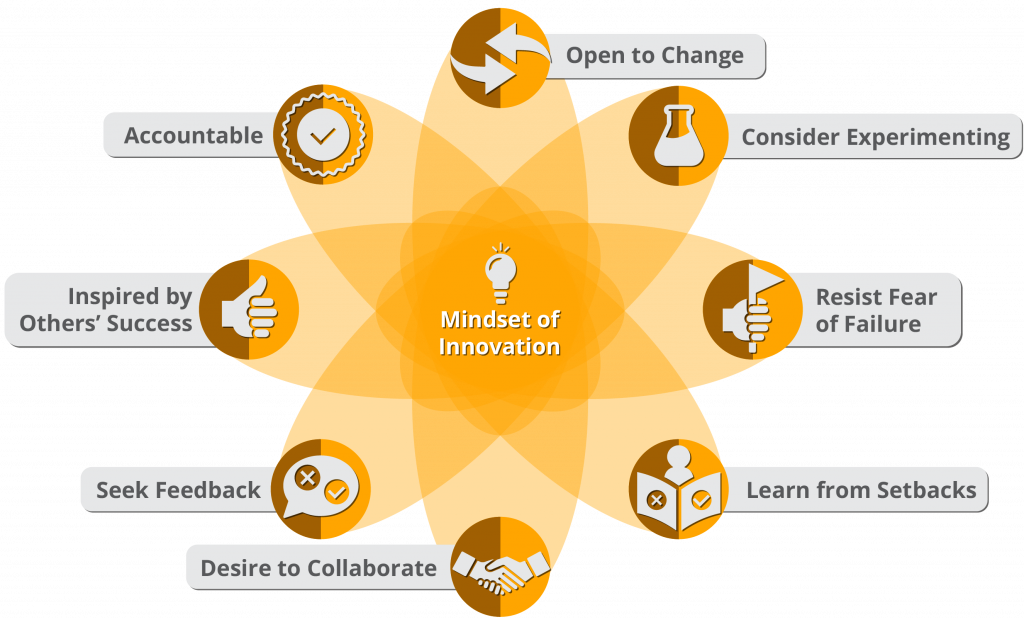“Innovation” is a word thrown around in every industry, but how do airports actually become innovative? One of the biggest keys to becoming innovative is developing a culture of innovation that permeates the whole organization. When innovation is viewed as a way of life instead of a set of one-off projects or a subset of the information technology department, airport operators can accomplish and sustain new projects that deliver real value to their organization.
The research team for ACRP Project 01-47, “A Guide to Developing a Culture of Innovation at Airports,” explored this topic in ACRP WebResource 16: Playbook for Developing a Culture of Innovation at Airports. This abbreviated summary presents key findings from the project and actionable next steps to help spur a culture of innovation in your organization.
Difference Between “Innovation” and a “Culture of Innovation”
Many organizations have started formalizing their innovation efforts, and findings from the research project demonstrate the importance of categorizing the conversation on innovation. Ed Essey of Microsoft Garage summarized this using three major ways that organizations view innovation: as fruit, a tree, or soil.[1] This led to the research team’s creation of Figure 1, which further differentiates “doing innovation” from a “culture of innovation.”
Figure 1: Viewpoints of Innovation
In the fruit viewpoint, innovation is seen as “doing projects,” which can demonstrate why innovation is needed and can spark the need for innovation.
In the tree viewpoint, innovation is seen as “having an innovation program,” which usually begins when airports create new executive positions related to innovation. Programs typically focus on teams carrying out transformative innovations.
In the soil viewpoint, innovation is seen as “being in the culture itself.” Innovation becomes a continuous cycle where soil (culture) is nourished, and the organization can plant more trees (programs) and bear more fruit (projects) as part of its cultural norms. This is not in opposition to the fruit and tree viewpoints; visible fruit is needed to demonstrate the value of shifting to a culture of innovation.
Key Organizational Elements that Influence Culture
An airport’s culture develops naturally over time. Research shows that airport culture most often reflects a combination of leadership style and overall strategic mission; however, culture is impacted by other organizational elements as well, such as staff, organizational structure, and process and procedure.
Each of these five organizational elements impacts culture in specific ways:
- Leaders shape an organization, and their style can influence many elements in the organization (e.g., open and inclusive vs. siloed and standardized).
- Staff shape an organization by their attitudes and mindset (e.g., open or closed to new ideas).
- Strategy and policy determine what values (e.g., cooperation vs. competition) are prioritized at an airport.
- Organizational structure reinforces the organizational style of the airport structure (e.g., hierarchical vs. flat) and promotes collaborative or individual work.
- Process and procedures demonstrate how to do daily work; they are structured to reward behaviors that leaders want to encourage.
Mindset Change Required for a Culture of Innovation

Figure 2: Innovative Mindset
To nurture innovation among the people in your organization, foster a change in mindset. People become more innovative once they develop a mindset that encourages innovation. This change will be different for each person. To understand how mindsets relate to innovation, see Figure 2 for the characteristics that constitute an innovative mindset.
Personas that Nurture or Harm a Culture of Innovation
The research team summarized the overarching behaviors, values, and norms of individuals in an organization into seven personas you can expect to see as you develop a culture of innovation. Understanding the personas of those around you—as well as yourself—will help you build a team that can effectively and efficiently effect this culture change. Of these seven personas, five are seen as positive personas (Table 1), necessary for innovation because they support an innovative mindset. The remaining two personas are considered negative (Table 2) and can pose challenges or barriers to innovation gaining traction in an organization.
Table 1: Positive Personas
|
|
Passionate individual always on the lookout for how to engage people, promote new initiatives, and make lasting and sustaining changes in the organization. |
|
|
Supportive of the organization and its people to pursue innovation. Actively promotes initiatives to see transformation. |
|
|
Anxious to get initiatives underway and see results. Works to tear down barriers hindering progress. |
|
|
Carries out necessary roles and responsibilities to sustain innovation initiatives. Does not actively promote innovation but also does not discourage others. Someone you can count on to get things done in support of innovation. |
|
|
May appear as if they are not on board when they really are; careful and conservative, they want to ensure success. |
Table 2: Negative Personas
|
|
Passively refuses to try new ideas and discourages others from participating in organizational initiatives supporting innovation. May lack the ability to empathize with colleagues and see the big picture as it relates to a culture of innovation. Needs coaching and other hands-on training initiatives to improve their perspective. |
|
|
Actively seeks opportunities to discourage innovation initiatives, and they may even consider low levels of sabotage. Lacks emotional maturity and does not work well with others. Unable or unwilling to understand and connect with people around them. |
Each Stakeholder Group Can Support Innovation
People in each airport business function play a pivotal role in incorporating innovation into an airport’s culture. However, some business functions may struggle to see their role in a culture of innovation more than others. In the research for this project, legal, procurement, and human resources typically made the top of the list. These business functions felt mired down in regulations or “processes and procedures” such that they could not see how to innovate. Look out for these stumbling blocks as you work to clear these challenging ideals and position all business functions to join your organization’s culture of innovation.
Synergies Between Airport Business Functions
Collaborative culture is a close cousin to a culture of innovation. When different departments come together to solve a problem or improve efficiency, they may already be innovating and not even recognize it.
Build on the Momentum You Already Have
There are several things you can do right now to help your organization transition to a culture of innovation, as demonstrated in Figure 3.

Figure 3: Formalizing Your Culture of Innovation Team
Uncover Existing Innovation
Innovation most likely already exists in your organization or within your team, you just need to find it.
Try Innovation
Find examples that demonstrate why a culture of innovation is desirable by assembling a cross-functional team to identify the most pressing current challenge, choosing which challenge to tackle first, and identifying a champion to lead the team in ideating, solving, planning, and implementing a solution.
Evaluate Your Results
Now that you have tried innovating, how did it go? Did you solve the challenges you set out to solve? If not, set out to pinpoint the exact reasons.
Celebrate Your Results
This is often overlooked in our modern, fast-paced culture. Once you have success, you need to share it. Highlight team members who worked hard to make it happen.
Continually Build on Your Team
If you started up an innovation team, evaluate how the team is doing. Try to invite new people (even those resistant to change) and find new challenges to solve.
Formalizing the Culture Change Process
The cultivation cycle has tremendous value, but to sustain innovation, consider building a program responsible for driving the culture change and tracking this process. Even if you already have an innovation program, you still need to consider culture change. Remember the difference between a culture of innovation and doing innovation; does your program focus mostly or entirely on bearing “fruit”? If so, it may not yet be equipped to manage your efforts to improve the “soil” (culture) of your organization. Decide whether this culture improvement element needs to be its own program or become part of your existing program.
See ACRP WebResource 16 for more on specific actions you can take to develop a culture of innovation in your organization.
References
[1] How to Unlock Your Innovation Growth with Fruits, Trees, and Soil, Edessey.com, Essey, Ed, July 31, 2018, https://edessey.com/fruits-trees-and-soil/.
Header photo by ameenfahmy on Unsplash, modified by Barich Inc.





 Catalyst
Catalyst Enabler
Enabler Accelerator
Accelerator Sustainer
Sustainer Challenger
Challenger Inhibitor
Inhibitor Destroyer
Destroyer